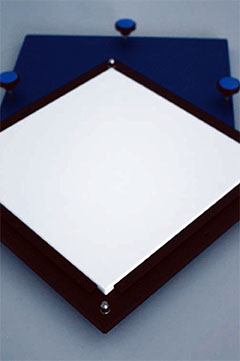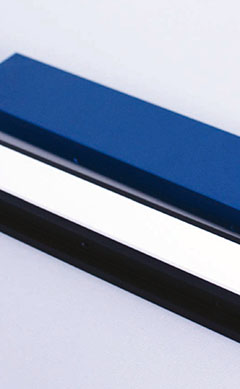Optopolymer® – Diffuse Reflecting Material
The optical diffusive reflecting material Optopolymer® is a plastic that is used in numerous photometric applications because of its high-quality production, purity, and highly diffusive reflectance behaviour. Our material has also gained acceptance among many users in optical metrology.
The following advantages make Optopolymer® indispensable in the optical industry and research.

Specifications
- Useful wavelength range 250 nm – 2.500 nm
- Reflectance > 98,5 % in the visible and 93 % in the wavelenth range 250 – 2.500 nm*
- Density 1.5 g/cm3
- Temperature range Min. -200 °C to max. +260 °C
- Hardness 30-40 Shore D
- Water solubility** Insoluble
- Resistance to chemicals High
- Flammability Non-flammable under UL class V-0
- High UV stability
*With a material thickness of min. 8 mm.
** The reflectance properties change in the case of damp or even wet material.
Basic Characteristics of our Diffusive Reflecting Material
Reflectance Behaviour: The extremely high reflectance behaviour of our Optopolymer® is caused by volume reflectance. This means, in order to achieve the specified reflectance values, the material thickness should be no less than 8 mm (a material thickness of 10 mm is recommended). If this material thickness is not possible in your application, a reduction in reflectance must be expected. Depending on the nature of the application, however, this feature can be reduced.
Material SurfaceOil, fat and other lipuid substances such as fingerprints have a serious impact on the reflectance of the material. Furthermore, shiny patches on the surface also alter the re- flectance behaviour. This impairs the almost ideal Lambertian characteristic. The ideal material surface should be “even and a little rough”.

Cleaning
Our optical diffusive reflecting material Optopolymer® is extremely resistant to chemical influences. This applies to acids, bases and other organic solvents. Because of the relatively high mechanical stability, it is possible to clean the material surface. The different methods of cleaning are largely dependent on the nature and level of the dirt. As such, dust can be removed simply with clean, dry air or nitrogen. If this is unsuccessful without further difficulty, pure alcohol may be used as an additional aid. Depending on the quantity of liquid cleaning agent used, it will penetrate more or less into the material. If this is the case, the liquid can be extracted from the material by heating. If mechanical damage to the reflectance side of the material occurs during this cleaning process, or even without it, the surface can be treated with fine sandpaper. You can also return the reflectance standard to us for cleaning. Bear in mind that the calibration data potentially pertaining to the reflectance standard will no longer be cor- rect. In this case, recalibration is required.